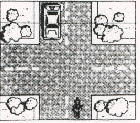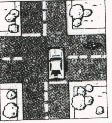| 彼の国は実地試験(後述)の簡単さに比べて学科試験が難しく、わたくしは2度も落ちました。 悔しいので同じ日に3度目を受けようとしたところ、運輸局のおばちゃんに 「今度落ちたら、4輪免許も取り消しよ!」 と耳打ちされ、青ざめて断念。 試験場を替えたら(San PedroからSanta Monicaへ)同じ問題が!(3種類しかないらしい) 今度は異常な早さで提出、しかも満点! 今度はおばさん仰天顔。 ハンドブックがあり、それを読んで受験するのだが、(わたくしには)とてもtrickyでした。 みなさんも、おためし下され。 TWO-WHEEL MOTORCYCLE EXAMINATION (中略) PASSING GRADE_4 ERRORS OR LESS 1.If you must slow down while turning: (a)Apply the rear brake only (b)Apply the rear brake, then the front brake (c)Apply both brakes at the same time (d)Never apply the brake 2.Not turning off a turn signal is most likely to: (a)Encourage another driver to pull into your path (b)Keep others from noticing your brake light (c)Encourage others to follow you too closely (d)Make your battery go dead 3.For greatest safety, your helmet should: (a)Fit loosely all the way around (b)Fit snugly all the way around (c)Fit tightly at the base; loosely at the top (d)Have a plastic chin guard 4.To handle a curve while on a slipperly surface, it is best to: (a)Slow down before you reach it (b)Downshift and use more throttle (c)Only use the rear brake to slow down (d)Lean less than you would on a nonslipperry surface 5.To avoid causing a rear end collision when you follow another vehicle: (a)Ride in the right wheel track (b)Stay at least three seconds behind (c)Ride in the left wheel track (d)tap your brakes lightly 6.When the motorcycle is stopped at an intersection, your passenger should: (a)Place both feet on the ground (b)Move forward on the seat (c)Keep both feet on the footpegs (d)Place one foot on the ground 7.If the rear tire goes flat: (a)The steering will feel heavy (b)You will not be able to maintain control (c)You will lose power to the rear wheel (d)The back of the cycle will jerk from side to side 8.Making eye contact with a driver at an intersection: (a)Is important if the driver is pulling out from a side street (b)Means that the driver will yield to you (c)Is important only if the driver is signaling for a left turn (d)Does not mean that the driver sees you 9.When you swerve in an emergency, it is important to: (a)Always brake before swerving (b) Always brake after swerving (c)Swerve in the direction the hazard is traveling (d)Stay in your own lane if possible 10.When you ride over a pothole: (a)Keep a normal seat position (b)Rise slightly off the seat (c)Lean forward as much as possible (d)Grip the gas tank with your knees 11.When you ride in traffic at night, the best way to locate bumps in the road is to: (a)Put your headlights on high beam (b)Watch the lights of the vehicle ahead (c)Read the road signs (d)Follow two seconds behind the vehicle ahead 12.Your passenger should: (a)Hold on to the seat strap (b)Hold on to the operator (c)Hold on to the side of the seat (d)Not ride without a backseat 13.If your throttle sticks: (a)Use the engine cut-off switch and pull in the clutch (b)Shift to neutral and apply both brakes (c)Downshift and apply both brakes (d)Twist the throttle back and forth twice to free the cable: 14. In this picture, riders are in a staggered formation. The following distance between A and C should be at least: (a)Four seconds (b)Two seconds fig.1 (c)Three seconds (d)Two car lengths
15.If the front wheel locks when you stop quickly: (a)Release and reapply the rear brake (b)Keep both brakes locked (c)Keep the front brakes locked untill fully stopped (d)Release and reapply the front brake 16.You should make a special point of checking traffic to the rear: (a)When carrying a passenger (b)When you ride through an intersection (c)Before slowing (d)Before starting into a curve 17.Compared to vehicles in traffic, how much room do motorcycles usually need to stop? (a)Approximately one-half the distance (b)About three-quarters the distance (c)At least as much distance (d)About twice the distance 18.In the picture, it is usually best for the rider to: (a)Slow down and ride close to the center line (b)Ride in position 1 fig.2 (c)Ride in position 2 (d)Slow down and ride in position 3
19.In the picture, the car driver is preparing to turn left. The motorcyclist should: (a)Increase speed but move to the right away from the approaching vehicle (b)Slow and move away fig.3 (c)Increase speed and hold position (d)Hold speed and move away
20.In the picture, the rear wheel locks while you try to stop quickly. It is usually best to: (a)Keep the rear wheel locked until stopped (b)Maintain position and release the rear brake fig.4 (c)Release the front brake and keep the rear brake locked (d)Lean the motorcycle and release the rear brake
21.To make a normal stop, the handbook recommends that you use: (a)The front brake only (b)The rear brake and downshift (c)Both front and rear brakes (d)The rear brake first and apply the front brake 22.You are being followed too closely. It is usually best to: (a)Move closer to the vehicle ahead (b)Move to the right position of the lane (c)Drop back farther from the vehicle ahead (d)Pass the vehicle ahead 23.A group of riders should move from a staggered formation into a single file when: (a)Traffic is heavy (b)Turning corners (c)Stopping at intersections (d)Riding at night 24.The best way to stay out of trouble is to see it coming. You do this by: (a)Identifying hazards (b)Knowing how to stop quickly (c)Watching for vehicles first, then pedestrians (d)Scanning ahead 25.Vehicle/motorcycle collisions are most common: (a)When carrying passengers (b)At intersections (c)At night (d)On city streets Answers: 1.c 2.a 3.b 4.a 5.b 6.c 7.d 8.d 9.d 10.b 11.b 12.b 13.a 14.c 15.d 16.c 17.c 18.c 19.b 20.a 21.c 22.c 23.b 24.c 25.b さて、いかがでした? 21問以上正解で合格です。 ちなみに私は6問間違え、不合格でした。 中には交通標語になりそうなもの、ことわざになりそうなものもありますね。 そういう意味で(どんな意味だ?)、問題8なんか、深いですよね。 「目があったからといって、その気になるな」みたいですね。 (By Mamoru) |



